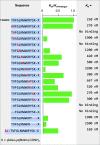De Novo Discovery of High-Affinity Peptide Binders for the SARS-CoV-2 Spike Protein
- PMID: 33527085
- PMCID: PMC7755081
- DOI: 10.1021/acscentsci.0c01309
De Novo Discovery of High-Affinity Peptide Binders for the SARS-CoV-2 Spike Protein
Abstract
The β-coronavirus SARS-CoV-2 has caused a global pandemic. Affinity reagents targeting the SARS-CoV-2 spike protein are of interest for the development of therapeutics and diagnostics. We used affinity selection-mass spectrometry for the rapid discovery of synthetic high-affinity peptide binders for the receptor binding domain (RBD) of the SARS-CoV-2 spike protein. From library screening with 800 million synthetic peptides, we identified three sequences with nanomolar affinities (dissociation constants K d = 80-970 nM) for RBD and selectivity over human serum proteins. Nanomolar RBD concentrations in a biological matrix could be detected using the biotinylated lead peptide in ELISA format. These peptides do not compete for ACE2 binding, and their site of interaction on the SARS-CoV-2-spike-RBD might be unrelated to the ACE2 binding site, making them potential orthogonal reagents for sandwich immunoassays. These findings serve as a starting point for the development of SARS-CoV-2 diagnostics or conjugates for virus-directed delivery of therapeutics.
© 2020 American Chemical Society.
Conflict of interest statement
The authors declare the following competing financial interest(s): B.L.P. is a cofounder of Amide Technologies and Resolute Bio. Both companies focus on the development of protein and peptide therapeutics.
Figures





References
-
- World Health Organization . Coronavirus Disease (COVID-19) Weekly Epidemiological Update for August 31st 2020; WHO, 2020.
-
- Tromberg B. J.; Schwetz T. A.; Pérez-Stable E. J.; Hodes R. J.; Woychik R. P.; Bright R. A.; Fleurence R. L.; Collins F. S. Rapid Scaling Up of Covid-19 Diagnostic Testing in the United States — The NIH RADx Initiative. N. Engl. J. Med. 2020, 383 (11), 1071–1077. 10.1056/NEJMsr2022263. - DOI - PMC - PubMed
-
- Zou L.; Ruan F.; Huang M.; Liang L.; Huang H.; Hong Z.; Yu J.; Kang M.; Song Y.; Xia J.; Guo Q.; Song T.; He J.; Yen H.-L.; Peiris M.; Wu J. SARS-CoV-2 Viral Load in Upper Respiratory Specimens of Infected Patients. N. Engl. J. Med. 2020, 382 (12), 1177–1179. 10.1056/NEJMc2001737. - DOI - PMC - PubMed
Grants and funding
LinkOut - more resources
Full Text Sources
Molecular Biology Databases
Miscellaneous

